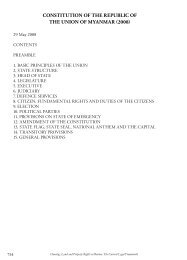Myanmar at the HLP Crossroads: - Displacement Solutions
Myanmar at the HLP Crossroads: - Displacement Solutions
Myanmar at the HLP Crossroads: - Displacement Solutions
Create successful ePaper yourself
Turn your PDF publications into a flip-book with our unique Google optimized e-Paper software.
<strong>Myanmar</strong> <strong>at</strong> <strong>the</strong> <strong>HLP</strong> <strong>Crossroads</strong> 38The St<strong>at</strong>e Peace and Development Council: 1997-2011On 15 November, 1997 <strong>the</strong> SLORC was abolished and reconstituted as <strong>the</strong> St<strong>at</strong>e Peace and DevelopmentCouncil (SPDC). Most but not all members of <strong>the</strong> abolished SLORC were in <strong>the</strong> SPDC. In 1998, <strong>the</strong> SPDCintroduced <strong>the</strong> Protection and Preserv<strong>at</strong>ion of Cultural Heritage Regions Law which enabled <strong>the</strong> Ministry ofCulture, with <strong>the</strong> approval of <strong>the</strong> government, to design<strong>at</strong>e and demarc<strong>at</strong>e areas as ancient monumental zones.The Ministry may also dismantle a building (which is not an ancient monument) and which obstructs <strong>the</strong> view ofan ancient monument. The Ministry can also prohibit ploughing and cultiv<strong>at</strong>ion with <strong>the</strong> boundary of an ancientmonument or site and prohibit building within <strong>the</strong> same areas.The Highways Law (2000) provides for <strong>the</strong> duties and powers of <strong>the</strong> Ministry of Construction, including, scrutinizingand permitting construction across highways, as well as construction and building within <strong>the</strong> boundary ofhighways. Under <strong>the</strong> Act it is an offence to build on or within <strong>the</strong> boundary of a highway. The City of MandalayDevelopment Law (2002) cre<strong>at</strong>ed a “City of Mandalay Development Committee”. The responsibilities of <strong>the</strong>Committee include: constructing, maintaining and demolishing buildings and demolishing and resettlement ofsqu<strong>at</strong>ter houses, squ<strong>at</strong>ter buildings and squ<strong>at</strong>ter wards. Finally, Order No. 3 (2007) confers certain powers on<strong>the</strong> Nay Pwi Taw Development Committee similar to those exercised by <strong>the</strong> City of Yangon and City of MandalayDevelopment Committees.Beyond <strong>the</strong>se measures, both <strong>the</strong> SLORC and SPDC used <strong>the</strong> <strong>HLP</strong> sectors as a means of simultaneouslyentrenching political power and subjug<strong>at</strong>ing <strong>the</strong> <strong>HLP</strong> domain to a household level tool of social control of <strong>the</strong>popul<strong>at</strong>ion. In accordance with <strong>the</strong> law, people’s homes are universally recorded and registered. Households onland parcels, deline<strong>at</strong>ed as individual property, (eing/myay paing saing mhu) are registered by local authoritiesand village headmen. This recording and registr<strong>at</strong>ion process enumer<strong>at</strong>es <strong>the</strong> head of household, loc<strong>at</strong>ion andtype of house and family characteristics. Local authorities <strong>at</strong> various community levels are oblig<strong>at</strong>ed to know <strong>the</strong>whereabouts and movements of <strong>the</strong> local popul<strong>at</strong>ion, which has <strong>the</strong> net effect of constant monitoring, surveillanceand control of dwellers by <strong>the</strong> local authorities. This degree of social control, <strong>the</strong> absence of privacy rights and anoverall environment of housing insecurity was worsened fur<strong>the</strong>r during <strong>the</strong> past two decades as a result of massiveforced eviction programmes pursued by both SLORC and SPDC.In January 1993 a N<strong>at</strong>ional Convention was formed for <strong>the</strong> purpose of drafting <strong>the</strong> Constitution. Of <strong>the</strong> 700initial deleg<strong>at</strong>es to <strong>the</strong> N<strong>at</strong>ional Convention (on 28 November 1995, <strong>the</strong> NLD withdrew its 86 represent<strong>at</strong>ives)nearly 600 were handpicked by <strong>the</strong> SPDC. The establishment and <strong>the</strong> manner of functioning of <strong>the</strong> N<strong>at</strong>ionalConvention raise serious questions of legality under both Burmese domestic law and intern<strong>at</strong>ional human rightslaw. Bearing those criticisms in mind, after 18 years a new Constitution was adopted on 29 May 2008. TheConstitution came into force after <strong>the</strong> scheduled 2010 elections. The Constitution follows <strong>the</strong> practice of <strong>the</strong>Revolutionary Council and SLORC in providing th<strong>at</strong> “existing laws shall remain in oper<strong>at</strong>ion in so far as <strong>the</strong>y arenot contrary to this Constitution until and unless <strong>the</strong>y are repealed or amended”. The Constitution reconfirms <strong>the</strong>position of <strong>the</strong> St<strong>at</strong>e as <strong>the</strong> primary land owner in <strong>the</strong> country: “<strong>the</strong> Union is <strong>the</strong> ultim<strong>at</strong>e owner of all lands and alln<strong>at</strong>ural resources above and below <strong>the</strong> ground, above and bene<strong>at</strong>h <strong>the</strong> w<strong>at</strong>er and in <strong>the</strong> <strong>at</strong>mosphere in <strong>the</strong> Union”.As noted below, in terms of individual <strong>HLP</strong> rights, <strong>the</strong> new Constitution enshrines rights for citizens including: <strong>the</strong>right of priv<strong>at</strong>e property, right of inheritance, right of priv<strong>at</strong>e initi<strong>at</strong>ive and p<strong>at</strong>ent in accord with <strong>the</strong> law; <strong>the</strong> right ofcitizens to settle and reside in any place within <strong>the</strong> Republic of <strong>the</strong> Union of <strong>Myanmar</strong> according to law; <strong>the</strong> rightto ownership, use of property and <strong>the</strong> right to priv<strong>at</strong>e invention and p<strong>at</strong>ent in <strong>the</strong> conducting of business if it is notcontrary to <strong>the</strong> provisions of this Constitution and <strong>the</strong> existing laws; and <strong>the</strong> guarantee th<strong>at</strong> <strong>the</strong> Union will protectaccording to law movable and immovable properties of every citizen th<strong>at</strong> are lawfully acquired.This colourful p<strong>at</strong>chwork of laws, developed under widely different systems of governance, has left <strong>Myanmar</strong> witha complex, almost impenetrable, legal framework for housing, land and property regul<strong>at</strong>ion. Indeed, it is oftenmore confusing than a source of <strong>the</strong> clarity, and overall constitutes a serious obstacle to building <strong>the</strong> rule of lawand gre<strong>at</strong>er transparency and fairness. Lax enforcement of long-standing land rights registr<strong>at</strong>ion requirementsand o<strong>the</strong>r formalities required by law has left <strong>the</strong> system of land registr<strong>at</strong>ion and mapping in severe disarray and<strong>the</strong> <strong>Myanmar</strong> people extremely vulnerable to land grabbing and o<strong>the</strong>r viol<strong>at</strong>ions of <strong>HLP</strong> rights in this vol<strong>at</strong>ile time.Moreover, virtually all decision-making is left to <strong>the</strong> unbridled discretion of appointees of <strong>the</strong> central Governmentwith little or no recourse to judicial review.













